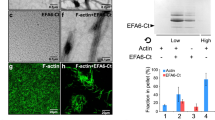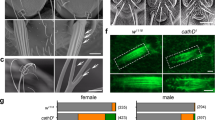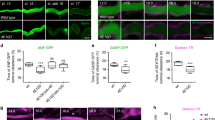Abstract
Redundant gene function frequently hampers investigations of the physiological roles of mammalian proteins. This is the case for Eps8, a receptor tyrosine kinase (RTK) substrate1 that participates in the activation of the Rac-specific guanine nucleotide-exchange function of Sos1 (refs 2–5), thereby regulating actin remodelling by RTKs. EPS8-knockout mice, however, exhibit no evident phenotype2, owing to the redundant function of three other EPS8-related genes6. Here we show that in the nematode Caenorhabditis elegans, only one orthologue of the EPS8 gene exists, which gives rise to two alternatively spliced isoforms, EPS-8A and EPS-8B, differing at their carboxyl termini. In the nematode, eps-8 is essential for embryonic development. Furthermore, EPS-8A, but not EPS-8B, is specifically required for proper apical morphogenesis in the intestinal cells. This latter phenotype could be precisely correlated with a previously unknown actin barbed-end-capping activity, which is present in the C terminus of the EPS-8A isoform. Therefore, nematode genetics allowed not only the unmasking of distinct EPS-8-linked phenotypes, but also the definition of a novel function for this molecule in actin dynamics.
This is a preview of subscription content, access via your institution
Access options
Subscribe to this journal
Receive 12 print issues and online access
$209.00 per year
only $17.42 per issue
Buy this article
- Purchase on Springer Link
- Instant access to full article PDF
Prices may be subject to local taxes which are calculated during checkout




Similar content being viewed by others
References
Fazioli, F. et al. Eps8, a substrate for the epidermal growth factor receptor kinase, enhances EGF-dependent mitogenic signals. EMBO J. 12, 3799–3808 (1993).
Scita, G. et al. EPS8 and E3B1 transduce signals from Ras to Rac. Nature 401, 290–293 (1999).
Scita, G. et al. An effector region in Eps8 is responsible for the activation of the Rac-specific GEF activity of Sos-1 and for the proper localization of the Rac-based actin-polymerizing machine. J. Cell Biol. 154, 1031–1044 (2001).
Innocenti, M. et al. Mechanisms through which Sos-1 coordinates the activation of Ras and Rac. J. Cell Biol. 156, 125–136 (2002).
Innocenti, M. et al. Phosphoinositide 3-kinase activates Rac by entering in a complex with Eps8, Abi1, and Sos-1. J. Cell Biol. 160, 17–23 (2003).
Offenhauser, N. et al. The eps8 family of proteins links growth factor stimulation to actin reorganization generating functional redundancy in the Ras/Rac pathway. Mol. Biol. Cell 15, 91–98 (2004).
Mongiovi, A. M. et al. A novel peptide-SH3 interaction. EMBO J. 18, 5300–5309 (1999).
Tocchetti, A., Confalonieri, S., Scita, G., Di Fiore, P. P. & Betsholtz, C. In silico analysis of the EPS8 gene family: genomic organization, expression profile, and protein structure. Genomics 81, 234–244 (2003).
Nehrke, K. A reduction in intestinal cell pH is due to loss of the Caenorhabditis elegans Na+/H+ exchanger NHX-2 increases life span. J. Biol. Chem. 278, 44657–44666 (2003).
Pantaloni, D., Boujemaa, R., Didry, D., Gounon, P. & Carlier, M. F. The Arp2/3 complex branches filament barbed ends: functional antagonism with capping proteins. Nature Cell Biol. 2, 385–391 (2000).
Mooseker, M. S. Organization, chemistry, and assembly of the cytoskeletal apparatus of the intestinal brush border. Annu. Rev. Cell Biol. 1, 209–241 (1985).
Ferrary, E. et al. In vivo, villin is required for Ca2+-dependent F-actin disruption in intestinal brush borders. J. Cell Biol. 146, 819–830 (1999).
DeRosier, D. J. & Tilney, L. G. F-actin bundles are derivatives of microvilli: What does this tell us about how bundles might form? J. Cell Biol. 148, 1–6 (2000).
Bartles, J. R. Parallel actin bundles and their multiple actin-bundling proteins. Curr. Opin. Cell Biol. 12, 72–78 (2000).
Gremm, D. & Wegner, A. Gelsolin as a calcium-regulated actin filament-capping protein. Eur. J. Biochem. 267, 4339–4345 (2000).
Disanza, G. et al. Eps8 controls actin-based motility by capping the barbed ends of actin filaments. Nature Cell Biol. 6, 1180–1188 (2004).
Anderson, P. Mutagenesis. Methods Cell Biol. 48, 31–58 (1995).
Salcini, A. E. et al. The Eps15 C. elegans homologue EHS-1 is implicated in synaptic vesicle recycling. Nature Cell Biol. 3, 755–760 (2001).
Timmons, L., Court, D. L. & Fire, A. Ingestion of bacterially expressed dsRNAs can produce specific and potent genetic interference in Caenorhabditis elegans. Gene 263, 103–112 (2001).
Confalonieri, S., Salcini, A. E., Puri, C., Tacchetti, C. & Di Fiore, P. P. Tyrosine phosphorylation of Eps15 is required for ligand-regulated, but not constitutive, endocytosis. J. Cell Biol. 150, 905–912 (2000).
Acknowledgements
The authors wish to thank the laboratory of Y. Kohara for providing cDNA clones; the Caenorhabditis Genetics Centre, which is funded by the National Institutes of Health National Centre for Research Resources, for some of the strains used in this work; the C. elegans KnockOut Consortium for the eps-8(ok539) allele; and A. Fire for reagents. We thank P. Transidico and C. Giuliani for technical assistance. We also thank J. Hodgkin, A.E. Salcini, M. Innocenti, P. Bazzicalupo and S. Arbucci for helpful discussions. This work was supported by grants from the AIRC (Associazione Italiana per la Ricerca sul Cancro) to P.P.D.F. and G.S.; the Human Science Frontier Program to P.P.D.F., G.S. and M.F.C.; the European Community (VI Framework) to P.P.D.F., R.B. and G.S.; the Italian Ministry of Health to P.P.D.F. and G.S.; the Fondazione Monzino to P.P.D.F.; and the Deutsche Forschungsgemeinschaft, and the Fonds der Chemischen Industrie to R.B. G.C. was supported in part by an EMBO long-term fellowship.
Author information
Authors and Affiliations
Corresponding author
Ethics declarations
Competing interests
The authors declare no competing financial interests.
Supplementary information
Supplementary Information
Fig S1, Fig S2, Fig S3, Fig S4 (PDF 153 kb)
Rights and permissions
About this article
Cite this article
Croce, A., Cassata, G., Disanza, A. et al. A novel actin barbed-end-capping activity in EPS-8 regulates apical morphogenesis in intestinal cells of Caenorhabditis elegans. Nat Cell Biol 6, 1173–1179 (2004). https://doi.org/10.1038/ncb1198
Received:
Accepted:
Published:
Issue Date:
DOI: https://doi.org/10.1038/ncb1198
This article is cited by
-
Human deafness-associated variants alter the dynamics of key molecules in hair cell stereocilia F-actin cores
Human Genetics (2022)
-
Rewiring of the ubiquitinated proteome determines ageing in C. elegans
Nature (2021)
-
The actin nucleator Cobl organises the terminal web of enterocytes
Scientific Reports (2020)
-
Developmental basis for intestinal barrier against the toxicity of graphene oxide
Particle and Fibre Toxicology (2018)
-
Plasticity of the brush border — the yin and yang of intestinal homeostasis
Nature Reviews Gastroenterology & Hepatology (2016)



